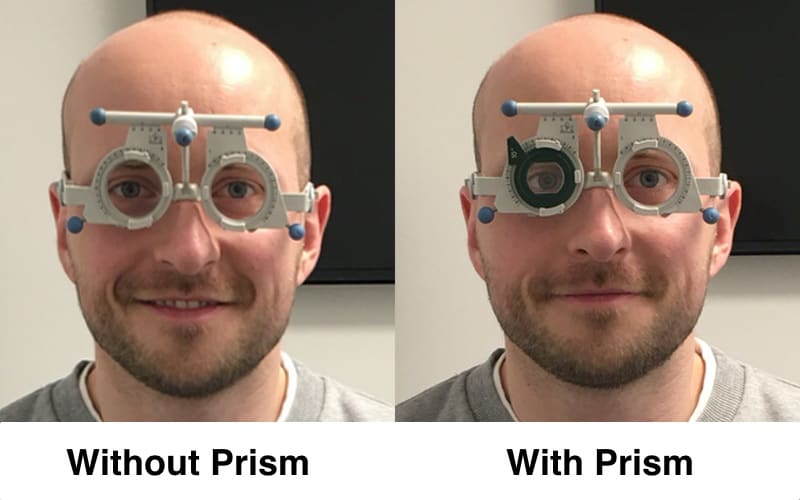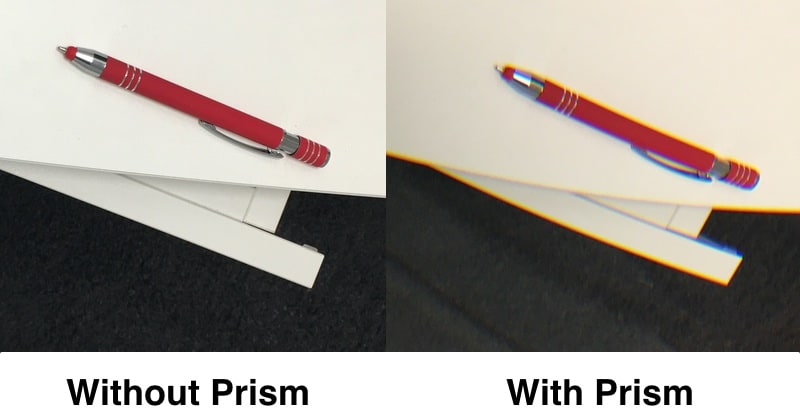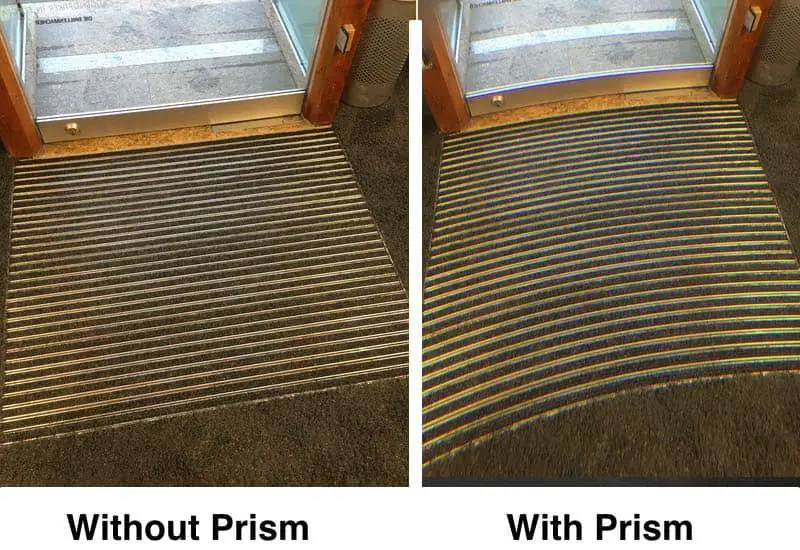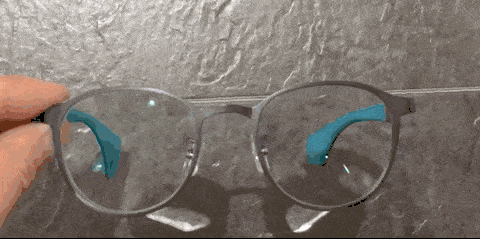In this article, you will find information with a lot of examples to know what it means for you to wear progressive lenses with prism. The experience can vastly differ from one person to another so take that into consideration while reading this.
First of all, prisms will be taken into consideration if binocular problems occur (headaches, eye strain, double vision). This can happen if you get a new prescription in your progressive lenses with an unequal amount of lens power (Anisometropia) or when the muscles attached to your eyeballs do not play together as they should. One way to get the prisms on your progressive lens fast is to get a prismatic foil if you already wear a pair of progressive glasses.

But the foil has some downsides. You will need to look through a lot of lines as you are using the foil. because the foil has many little prisms on its surface to get the prescription you need. And if you already wear progressive glasses the lens design is not customized for the prismatic power to let you see you through the reading zones as you look down. Just think about it. You have a fixed corridor in the lens in which you can see clearly which has just a few millimeters of width.
Now with a prism foil attached to your lens, your eye will wander into a different position. But your reading zones in the lenses can not be moved in your already made progressive glasses. Therefore the foil is great for testing or as an interims solution but to provide you the best visual comfort the prism directly needs to be considered in the production process of your progressive lens. And that is exactly what we will read about as you go on.

There is a formula that tells the optician how to decenter the lens design in combination with prims. It is 0,25 mm decentration per 1cm/m (power of prism) in the opposite direction of the prism base. This sounds complicated at first but lets me clear things up with a simple example. If the base (the thickest part of the prism lens) is placed just on the left and right ends of your frame the lens has to be placed more with a decentered pupilar distance which is smaller than your actual pupilar distance without the prism.

This is necessary to place the lenses correctly to match your eyes’ deviated position as soon as you wear the prism. When the prism sits nasal your pupilar distance has to be decentered to make it bigger. There are a few things more to consider when getting your prescription out of the trial lens into the ordering process but as I write this for you being the end consumer I do not want to get overly complicated here.
What Prisms Mean for Progressive Lens Design
The prism lets your eyes position in a for the eye muscles balanced state. That means if a person with prisms looks straight ahead will have one eye that deviates from its straightforward position in another position. This position is dependent on the base of the prism and how big the prism needed actually is. As you think about it with progressive lenses you have just a few millimeters of reading zones in front of you. If one eye deviates from the straight forward position this should be taken into consideration.
If not the wearer of the progressives with prism will get a smaller reading zone. How small depends on how far the reading zone is decentered from its optimal position. Prisms, in general, minimize the clarity of vision if eye movements are performed into the periphery of the lenses. The bigger the prism the bigger the loss of visual acuity. With customizations to your lens design all that can be taken into account to minimize the distortions and the loss of visual acuity.
Depending on how high the power of your prism is you will still experience these mentioned side effects with the customization. But the side effects will be less noticeable. I mention here some lenses I would consider when having prism especially when they exceed 6cm/m:
- Essilor Varilux X f360
- Zeiss Individual 2
- Seiko Brilliance
- Hoya iD MyStyle V+
- Shamir Autograph Intelligence
Those lenses take a few things into consideration. For example, how the frame sits in your face, is it more tilted, how far is your popular distance, how far is the distance from your eyes to the lens, and so on. If those parameters are taken into account your fields of view will be as big as possible. Having issues in the periphery with blurry vision is normal when prisms are higher. The lenses are just optimized for one situation and that is when you are looking straight ahead.
As soon as you perform eye movements you can notice the blurriness increasing. Some wearers notice it more some less. The reason is astigmatisms occurring due to the physics of optics. Prisms, in general, will lead to thicker lenses. Depending on the amount of prisms needed and where the base of the prism sits in your prescription it is barely noticeable that there are any prisms to a big difference in aesthetics and added weight.
I highly advise you to let the optician calculate the thickness of the lenses and the weight when comparing new frames to see if there are significant differences when you compare new frames. Oftentimes the optician can do this for you during the consulting process. It might take a few minutes but it is time well spent if you spot bigger differences which make years wearing your progressive lenses with prisms a better experience.
What Lens Materials Should I Consider When Buying Progressive Lenses with Prism
Thinner-made Plastic lenses are in most cases the best tradeoff between aesthetics and weight. The higher you go with the material index the thinner your lenses will be. But If you buy extremely thin lens materials you might notice the aberrations more. It is a color fringe often found around bright objects. Some wearers of prism glasses find that annoying and others are less sensitive to that topic. If you have a problem with these color fringes try to go down one option in the materials. You probably will have fewer aberrations now.

Here in our example, we calculated the thickness for a right and a left progressive lens with vastly different prisms. Both have their thickest parts tunes outside.
| SPH | CYL | A | ADD | Prism | Base | |
| R | -2,00 | +2,00 | 2 | 180 | ||
| L | -2,00 | +2,00 | 10 | 0 |
What I will show you now are the different calculations with the available plastic materials for both eyes. Only the thickest part is shown here.

All the Calculations are made for average parameters. The pupilar distance was 32mm for both eyes and the frame has a horizontal size of 53mm which is pretty common. These calculations need to be done with your individual prescriptions in combination with the frame and your centration.
Side note by me.
| Index of Lens Material | R (2cm/m) MAX Thickness | L (10cm/m) MAX Thickness |
| 1,5 | 3,98 mm | 11,93 mm |
| 1,6 | 3,70 mm | 10,48 mm |
| 1,67 | 3,47 mm | 9,46 mm |
| 1,74 | 3,30 mm | 8,92 mm |
Now that you´ve seen the thickness of the lenses produced by the prism I want to give you some perspective on how the lenses look like. Most plastic frames have a thickness of around 4mm. Some are a little bit thicker and some are thinner but the majority falls in this range. If you paid attention to the numbers in the column with the smaller Prism (2cm/m) the material of the lens would be completely hidden behind the frame.
Compared to that the bigger prism (10cm/m) on the other side will stick out on the side of the frame which is facing you. And the lens would be more than two times thicker compared to the frame. To further reduce the thickness here another frame should be considered with smaller dimensions to get a smaller and thinner lens. In a lot of cases, people the prisms can be split up which thins the lenses significantly. But you need to speak to your optician about that.
The Unequal Lens Powers in Your Right and Left Eye with Progressives
When you get your progressives first progressive lenses and they do not have prisms built-in they do produce prismatic effects which can lead to the same effects when a prism is needed and it is not yet built into the progressive lenses yet. Those effects are already mentioned above:
- double vision
- headaches
- eyestrain
Your eyes are just perfectly working together if the pictures they see the overlap. But when you have an unequal amount of lens power (like +2,0D in your right eye and -1,0D in your left eye) you will probably notice the picture jump up or down if you close one eye at a time and you compare both pictures. You can get around this (prismatic powers) depending on how big the difference is and what your eyes are still capable of compensating by:
- Getting a short progressive lens design
- Compensating the lens power with a contact lens on one eye
- Getting a slab off minimizes the prismatic effects as you look down
1. Short Lens Design and How It Minimizes Problems of Unequal Powers in Progressive Lenses
There is one point in the lens that holds the desired prismatic power and it is 4mm under your point on the lens if you are looking straight ahead in the distance. By performing eye-movements up or down prismatic effects could lead to problems like double vision. The bigger the distance from the ideal point of prismatic powers the higher the probability of double vision because with an increase of the distance you get more prismatic effects.
In progressive lenses, you always have the choice to choose from a longer or shorter lens design. Those terms describe if you need to perform big eye movements down to read (long) or do you just need a slightly more downward positioned look to read (short). In a longer design, you are forced to perform bigger eye movements otherwise you will not get into the reading zone. As you need to look more down compared to a shorter lens you have the advantage of a bigger zone for the laptop distance.
If you have a shorter lens the mentioned prismatic side effects are less dominant but you will also lose a big part of the laptop distance. What to choose is highly dependable on how much your eyes can compensate. This is really different from the wearer to wearer per se and about the prescription. Some people can also handle big differences in lens power easily but mostly because one eye gets suppressed and the other eye takes over all the work.
2. Compensating the Lens Power with a Contact Lens on One Eye
To get around the prismatic powers one good way is to make your eyes equal with a contact lens on one eye. If this is done correctly both eyes can now have the same lens power and progressive suddenly get a lot easier to handle. This just eliminates the imbalance of prismatic powers as you perform eye-movements up and down in the lens. When prisms are already needed in your prescription they will not be minimized.
3. Getting a Slab off to Minimize Unwanted Prismatic Effects
If none of the above options is for you then get a slab off. This is a special grinding technique to balance the unequal amount of prismatic powers in the left and right lens. What happens when you get a slab off you will notice a fine line from the left to the right on one of the lenses. The higher the difference in diopters the more noticeable will the line be. The signs when to get a slab off are pretty clear for us opticians:
- If you experience double vision even with a short lens design
- If you have glasses on and it gets really tiring and blurry after a few minutes
Here are the signs when to stay away from a slab off:
- If you have an unequal amount of lens power in the right and left lens and it works well for you
- You are only using one eye at a time. No Binocular vision
- If it is unclear if this is the problem
How Long Does It Take to Adjust to Prism Glasses?
The time to adjust to prism glasses in combination is highly dependable on the amount of prism needed and the ability of the wearer to adapt to the new visual experience. When distortions are low 2-3 days are common to get used to them. But if distortions are high it might take a couple of weeks to get used to your new prism glasses.
The reason is prisms can change your perception of depth perception. You might have a hard time in the first few days to adjust because if you drove a car for the last 15 years and you perceived 15 meters as 15 meters but all of a sudden things feel a lot further away you must relearn those situations. And that usually takes time. In some cases, it is the distances that need to be relearned sometimes straight lines are bent and the bottom appears to be globular.

To all that, your body can adjust but realistically speaking here it is highly dependable on the power of prisms needed. You can not compare a pair of glasses with 2cm/m (the amount of prisms needed) with a pair of 12cm/m prisms needed. The latter needs more instructions and more time as he will experience far more blurriness when performing eye movements into the periphery as one with fewer prisms needed.
How Are Prisms Measured in Progressive Lenses?
The prescribed amount of Prisms in progressives lenses can only be measured in the prism reference point which is in the middle of the engravings of a progressive lens. However, the real prismatic power experienced by the wearer can only be calculated if the optician knows where the wearer of the progressive lenses is looking through the lens. This position determines the amount of progressive power the wearer will experience.
What Is the Cost of Progressive Lenses with Prism?
Depending on the lens design and manufacturer you choose prices can vary from 250$ up to 1300$. There are really big differences in what you can buy and what can be considered to enhance your visual experience. Especially when prims come into play it usually pays to get high-end lenses. Otherwise, you could experience a very small field of view in which you can only perform minimal eye movements to avoid blurriness.
However, this does not mean a lower-priced progressive lens with a prism can not work. But the probability is higher you will notice the differences in lower-priced and high-end lens design.
Examples of What to Expect with Different Prisms in Your Progressive Lenses
Example No 1 Progressive Lenses with Prism
| SPH | CYL | AXIS | ADD | Prism | Base | |
| R | +1,00 | -2,00 | 0° | 2,00 | 1,5 | 0 |
| L | +1,00 | -2,00 | 90° | 2,00 | 1,5 | 180 |
The power of the prism is not big in most cases people feel that their eyes play a little better together and everything looks a little bit more 3D now with the new glasses. So the prisms here are totally nothing that needs a lot of consultation. Here, in this case, prismatic changes are big as eye movements are made up and down and from side to side. And as these lenses are progressives this person is forced to look down through the reading zones.
If this person already wears progressives without a problem there is nothing to worry about. But if this person just wore single vision lenses before he is probably not used to perform eye movements. He used more head movements to look in a certain direction. In this case, the optician must pay attention to near vision (and eye movements from left to right) with special adjustments of the trial frame to know what to expect with the progressive lenses as the customer gets them.
If the prismatic effects are too high for the person to tolerate it would be wise to compensate for this effect with contact lenses. These contacts would then correct the CYL also known as astigmatism. If this happened the wearer could easily perform eye movements up and down and from side to side.
In some cases, customers don´t want or can not deal with contact lenses. Then if problems arise during the test while reading a slab off should be considered. This places a fine line on one lens and therefore compensates the unwanted prismatic effects produced by astigmatism. But the effects are only compensated when the customer looks down.
When in an everyday situation in the car he wears his progressives and he wants to check the left and right with eye movements if the streets are free to drive he will probably still experience huge prismatic effects due to astigmatism. The power of astigmatism that causes a problem here is determined by the Axis. In this case, 0° and 90° will produce prismatic effects that make it really hard to adjust to those lenses.
So if you have astigmatism in your glasses don´t worry it does not has to cause problems with prismatic effects. And if you have astigmatism that produces prismatic effects consider the options above to compensate for those effects.
Example No 2 Progressive Lenses with Prism
| SPH | CYL | AXIS | ADD | Prism | Base | |
| R | -3 | -1,0 | 180 | 2,50 | 3 | 180 |
| L | -3 | -1,0 | 178 | 2,50 | 3 | 0 |
In this case, the person who wears progressive lenses with prism would probably say: “Wow, it feels a little more 3D like” but the rest of the prescription is really not problematic. The person may have to adjust to the lenses for a short time but in a few days, this will not be an issue anymore. The lenses in this case just start out to produce a noticeable amount of aberrations which will produce slightly blurry vision when the wearer performs big eye movements.
As soon as the prism exceeds a value of 2cm/m people with a really high visual acuity tend to notice them. The bigger the prism the more noticeable they get. When dealing with the prism and progressive lenses in combination for the first time a little more time should be given until the lenses can be tolerated. The reason is the new head movements that need to be performed to avoid blurry vision in the periphery.
If the wearer notices distortions they are a byproduct of the progressive lenses in some cases with the prism straight lines may suddenly appear bent or a 90° angle looks somehow more or less bent if you have a closer look at the edges of a book. These effects are totally normal and they will disappear with time.

Example No 3 Progressive Lenses with Prism
| SPH | CYL | AXIS | ADD | PRISM | BASE | |
| R | -6,00 | -2,00 | 0 | 2,00 | 9 | 180 |
| L | -7,00 | -1,50 | 170 | 2,00 | 9 | 0 |
This person here has high myopia in combination with astigmatism and he needs a big prism in order to fuse both images together. He came into our store with the description of always having trouble concentrating on a point. Because without prism the point will split up slowly until he sees two points. In these cases, he tolerated the lenses instantly although he noticed the color fringes directly and the periphery appeared a bit blurry to him.
But his main problem was solved. His eyes were constantly trying to stabilize the picture and after he wore the glasses for a few minutes he could not think about switching back to his older glasses. This customer from us is a rare case. Just a really small percentage would benefit from such a big amount of prisms. When testing people a lot of them show signs of a little imbalance in their eye muscles.
That would lead to prims in their lenses but not everybody benefits from them or even notices them. It is always up to the optician what gets measured and what not to be able to see if a customer would benefit from prisms in their prescription. This article represents general information for you as a customer. I did not want to go too much into detail as it would just blow up the article too much.
